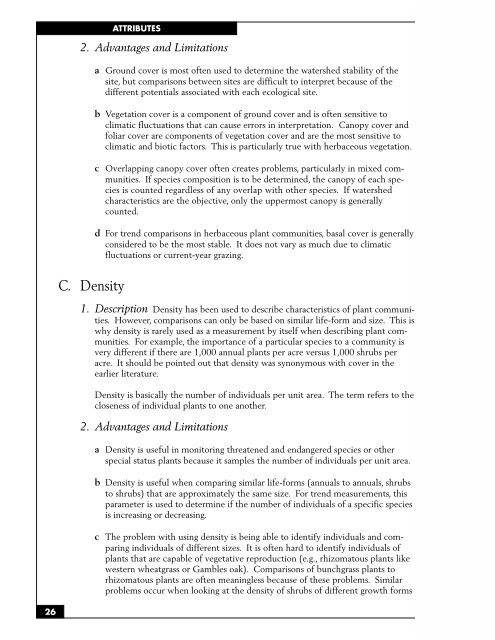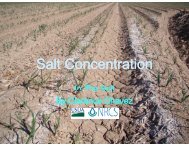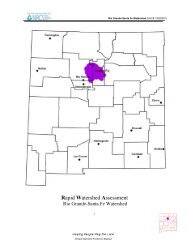SAMPLING VEGETATION ATTRIBUTES - New Mexico NRCS - US ...
SAMPLING VEGETATION ATTRIBUTES - New Mexico NRCS - US ...
SAMPLING VEGETATION ATTRIBUTES - New Mexico NRCS - US ...
You also want an ePaper? Increase the reach of your titles
YUMPU automatically turns print PDFs into web optimized ePapers that Google loves.
26<br />
<strong>ATTRIBUTES</strong><br />
2. Advantages and Limitations<br />
C. Density<br />
a Ground cover is most often used to determine the watershed stability of the<br />
site, but comparisons between sites are difficult to interpret because of the<br />
different potentials associated with each ecological site.<br />
b Vegetation cover is a component of ground cover and is often sensitive to<br />
climatic fluctuations that can cause errors in interpretation. Canopy cover and<br />
foliar cover are components of vegetation cover and are the most sensitive to<br />
climatic and biotic factors. This is particularly true with herbaceous vegetation.<br />
c Overlapping canopy cover often creates problems, particularly in mixed communities.<br />
If species composition is to be determined, the canopy of each species<br />
is counted regardless of any overlap with other species. If watershed<br />
characteristics are the objective, only the uppermost canopy is generally<br />
counted.<br />
d For trend comparisons in herbaceous plant communities, basal cover is generally<br />
considered to be the most stable. It does not vary as much due to climatic<br />
fluctuations or current-year grazing.<br />
1. Description Density has been used to describe characteristics of plant communities.<br />
However, comparisons can only be based on similar life-form and size. This is<br />
why density is rarely used as a measurement by itself when describing plant communities.<br />
For example, the importance of a particular species to a community is<br />
very different if there are 1,000 annual plants per acre versus 1,000 shrubs per<br />
acre. It should be pointed out that density was synonymous with cover in the<br />
earlier literature.<br />
Density is basically the number of individuals per unit area. The term refers to the<br />
closeness of individual plants to one another.<br />
2. Advantages and Limitations<br />
a Density is useful in monitoring threatened and endangered species or other<br />
special status plants because it samples the number of individuals per unit area.<br />
b Density is useful when comparing similar life-forms (annuals to annuals, shrubs<br />
to shrubs) that are approximately the same size. For trend measurements, this<br />
parameter is used to determine if the number of individuals of a specific species<br />
is increasing or decreasing.<br />
c The problem with using density is being able to identify individuals and comparing<br />
individuals of different sizes. It is often hard to identify individuals of<br />
plants that are capable of vegetative reproduction (e.g., rhizomatous plants like<br />
western wheatgrass or Gambles oak). Comparisons of bunchgrass plants to<br />
rhizomatous plants are often meaningless because of these problems. Similar<br />
problems occur when looking at the density of shrubs of different growth forms




